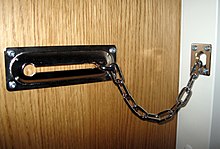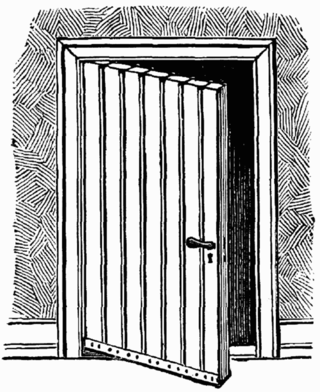
A door is a hinged or otherwise movable barrier that allows ingress (entry) into and egress (exit) from an enclosure. The created opening in the wall is a doorway or portal. A door's essential and primary purpose is to provide security by controlling access to the doorway (portal). Conventionally, it is a panel that fits into the doorway of a building, room, or vehicle. Doors are generally made of a material suited to the door's task. They are commonly attached by hinges, but can move by other means, such as slides or counterbalancing.
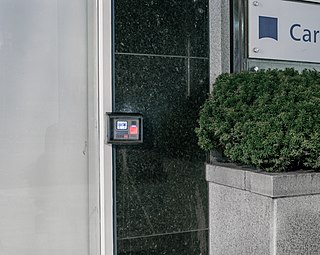
In physical security and information security, access control (AC) is the selective restriction of access to a place or other resource, while access management describes the process. The act of accessing may mean consuming, entering, or using. Permission to access a resource is called authorization.

Handcuffs are restraint devices designed to secure an individual's wrists in proximity to each other. They comprise two parts, linked together by a chain, a hinge, or rigid bar. Each cuff has a rotating arm which engages with a ratchet that prevents it from being opened once closed around a person's wrist. Without the key, the handcuffs cannot be removed without specialist knowledge, and the handcuffed person cannot move their wrists more than a few centimetres or inches apart, making many tasks difficult or impossible.

A hinge is a mechanical bearing that connects two solid objects, typically allowing only a limited angle of rotation between them. Two objects connected by an ideal hinge rotate relative to each other about a fixed axis of rotation, with all other translations or rotations prevented; thus a hinge has one degree of freedom. Hinges may be made of flexible material or moving components. In biology, many joints function as hinges, such as the elbow joint.

A lock is a mechanical or electronic fastening device that is released by a physical object, by supplying secret information, by a combination thereof, or it may only be able to be opened from one side, such as a door chain.
A child safety lock is a special-purpose lock for cabinets, drawers, bottles, etc. that is designed to help prevent children from getting at any dangerous things or contents. Young children are naturally curious about their surroundings and will always explore, but as they may be unaware of dangerous substances or situations, the results can be fatal. Numerous cases of poisoning have resulted from eating brightly colored pills or spilling cleaning solvents.

A bank vault is a secure space where money, valuables, records, and documents are stored. It is intended to protect their contents from theft, unauthorized use, fire, natural disasters, and other threats, much like a safe. Unlike safes, vaults are an integral part of the building within which they are built, using armored walls and a tightly fashioned door closed with a complex lock.
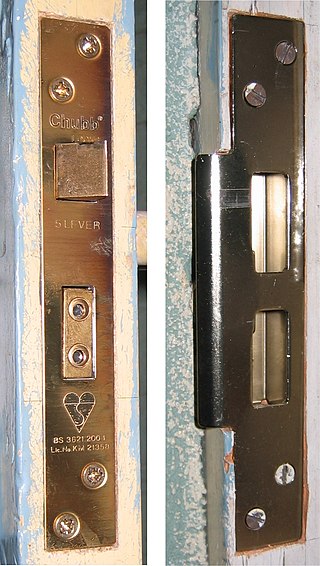
A mortise lock is a lock that requires a pocket—the mortise—to be cut into the edge of the door or piece of furniture into which the lock is to be fitted. In most parts of the world, mortise locks are found on older buildings constructed before the advent of bored cylindrical locks, but they have recently become more common in commercial and upmarket residential construction in the United States. The design is widely used in domestic properties of all vintages in Europe.

A crash bar is a type of door opening mechanism which allows users to open a door by pushing a bar. While originally conceived as a way to prevent crowd crushing in an emergency, crash bars are now used as the primary door opening mechanism in many commercial buildings.
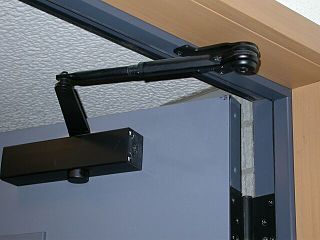
Door furniture or door hardware refers to any of the items that are attached to a door or a drawer to enhance its functionality or appearance.

A door handle or doorknob is a handle used to open or close a door. Door handles can be found on all types of doors including exterior doors of residential and commercial buildings, internal doors, cupboard doors and vehicle doors. There are many designs of door handle, depending on the appropriate use. A large number of handles, particularly for commercial and residential doors, incorporate latching or locking mechanisms or are manufactured to fit to standardised door locking or latching mechanisms.

A garage door opener is a motorized device that opens and closes a garage door controlled by switches on the garage wall. Most also include a handheld radio remote control carried by the owner, which can be used to open and close the door from a short distance.

A bicycle lock is a security device used to deter bicycle theft, either by simply locking one of the wheels or by fastening the bicycle to a fixed object, e.g., a bike rack.

An electronic lock is a locking device which operates by means of electric current. Electric locks are sometimes stand-alone with an electronic control assembly mounted directly to the lock. Electric locks may be connected to an access control system, the advantages of which include: key control, where keys can be added and removed without re-keying the lock cylinder; fine access control, where time and place are factors; and transaction logging, where activity is recorded. Electronic locks can also be remotely monitored and controlled, both to lock and to unlock.

The term door security or door security gate may refer to any of a range of measures used to strengthen doors against door breaching, ram-raiding and lock picking, and prevent crimes such as burglary and home invasions. Door security is used in commercial and government buildings, as well as in residential settings.

A gun safe is a safe designed for storing one or more firearms and/or ammunitions. Gun safes are primarily used to prevent access by unauthorized or unqualified persons, for burglary protection and, in more capable safes, to protect the contents from damage by flood, fire or other natural disasters.

The Lock Museum is a private museum in Seoul, South Korea. It is directed by Mr. Hongkyu Choi.

An electromagnetic lock, magnetic lock, or maglock is a locking device that consists of an electromagnet and an armature plate.

A lockset is the hardware and components that make up the locking or latching mechanism that can usually be found on a door or other hinged object but can also include sliding doors and dividers. The components of a lockset can include the door handles, latch bolt, dead bolt, face plate, strike plate, escutcheon, thumbturn, push button, turn button, and other trim. The lockset and associated hardware typically defines a door's function and how a user could access the two adjacent spaces defined by the opening associated with the lockset.
An officer’s tool is a forcible entry device used by firefighters and other first responders. Officer’s tools are designed to completely remove cylindrical locks from doors without causing major structural damage, allowing for direct access to the internal locking mechanism.
